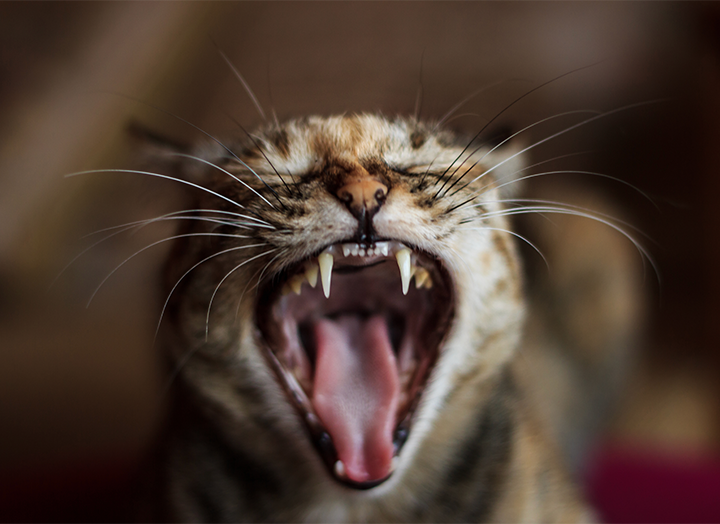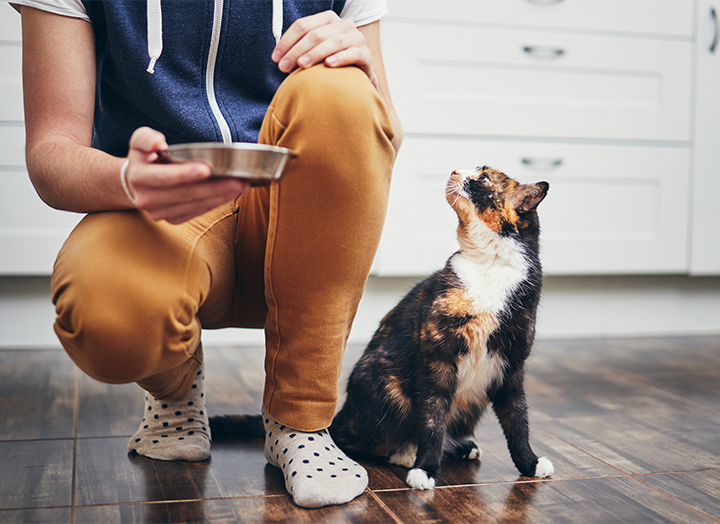[vc_row][vc_column][vc_column_text css=””]
If there’s one thing that makes us flash our pearly whites into a big smile, it’s knowing that our pet’s health is in good condition. Speaking of pearly whites, it’s just as important to take care of your cat’s teeth as it is to take care of your own. Designing a dental routine for them will not only prevent them from developing diseases but will keep them happy and healthy down the line.
If you’re looking for some tips on how to improve your cat’s oral health, you’ve come to the right place!
[/vc_column_text][/vc_column][/vc_row][vc_row][vc_column][vc_row_inner content_placement=”middle”][vc_column_inner width=”1/2″][vc_column_text css=””]
Why is cat dental health important?
Did you know that cats have 30 permanent teeth consisting of 12 incisors, 4 canines, and 10 premolars? Way before our fur babies were ever domesticated, they took cat oral care into their own hands (or paws) by chewing on grass or bones, but in the present day as household pets, they don’t have that luxury.
Now, as pet owners, it’s our duty to ensure their teeth are in tip-top condition. Just like us, cats are susceptible to a number of tooth problems.
Of these tooth problems, they can experience gum disease and plaque buildup, which is why it’s so important to keep an eye on their teeth. When not taken care of, poor dental hygiene can cause issues in the cat’s heart, liver, and kidneys. [/vc_column_text][/vc_column_inner][/vc_row_inner][vc_row_inner content_placement=”middle”][vc_column_inner width=”1/2″][vc_column_text css=””]
What are the most common cat dental diseases?
We’re very similar to our feline counterparts in the sense that we can both be affected by similar dental diseases. While some are very rare, there are others that rear their head more frequently. The most common of these are gingivitis, periodontitis, and tooth resorption, but regular upkeep and preventative cat oral care are the keys to long-term dental health and overall wellness.
If you do not yet have a cat or are thinking of getting another one, it’s good to note that certain breeds are hereditarily prone to dental issues like the Persian, Maine Coon, and Siamese. [/vc_column_text][/vc_column_inner][vc_column_inner width=”1/2″][vc_column_text css=””]
Healthy cat teeth vs unhealthy
When examining your cat’s teeth, there may be some things that stand out more than others, and some things you may not notice at all. We’ve put together the following guide to help you determine healthy cat teeth vs unhealthy.
[/vc_column_text][/vc_column_inner][/vc_row_inner][vc_row_inner content_placement=”middle”][vc_column_inner width=”1/2″][vc_column_text css=””]
How to determine healthy cat teeth
If you’re wondering what condition your cat’s teeth are in, here are a few indicators to tell if they’re healthy:
- A healthy cat’s teeth should be clean
- The teeth should be white
- Look for chips in the teeth. We understand that some things can’t be prevented, but the fewer chips the better
Once you’ve checked their teeth, examine their gums for any sores or lesions. If the gums are healthy, they should be pink and without any redness, swelling, or bleeding.[/vc_column_text][/vc_column_inner][vc_column_inner width=”1/2″][vc_column_text css=””]

How to determine unhealthy cat teeth
There are a few telltale signs to help determine if your cat may be experiencing any dental concerns. Check them out below:
- Bad breath could be related to a dental condition, but could also suggest some sort of digestive issue
- Look for bleeding or a dark red line along the gums
- Swollen gums. Keep an eye on these as they can lead to gum disease, tooth loss, inability to eat, and more
- Gum ulcers
- Excessive drooling
- Difficulty eating
[/vc_column_text][/vc_column_inner][/vc_row_inner][vc_row_inner content_placement=”middle”][vc_column_inner width=”1/2″][vc_column_text css=””]
How to keep cat teeth healthy
Although they might not be a fan, you should try to get your cat used to getting their teeth brushed at least twice weekly. Most cats are pretty finicky with change and might be resistant to having your fingers in their mouth, so starting when they’re a kitten will help them get used to the process.
If this doesn’t work with your cat, you can try feeding them a more dental-friendly diet, like our Bold by Nature pet raw food.
Lastly, it’s always important to get your cat in for regular vet visits and checkups.[/vc_column_text][/vc_column_inner][vc_column_inner width=”1/2″][/vc_column_inner][/vc_row_inner][vc_row_inner content_placement=”middle”][vc_column_inner width=”1/2″][vc_column_text css=””]
How can a raw diet help cat dental health?
Since cats are considered obligate carnivores, they don’t just thrive on an all-meat diet, but they actually need it to survive! Their teeth are built for eating meat and are designed to tear away at the bone’s surroundings. Not only do cats love the taste of a raw diet, but they also get to reap the benefits while they feast, like dental help.
A Bold by Nature raw diet may help to promote excellent oral hygiene in your cat, as our diets eliminate carbohydrates, fillers, and unnecessary sugars normally found in dry foods and kibbles. Kibble is also known to stick to a cat’s teeth. The high moisture content found in Bold by Nature raw food can help prevent the stickiness of food in teeth.
So not only is it great cat food for dental health but many other facets of their life, too! It is known to be the best food for a cat with allergies, a great option as cat food for hyperthyroidism, and it could be a healthy choice as cat food for kidney disease.
Even feeding a raw treat can be a one-way ticket to healthy cat teeth. Giving your cat Bold by Nature raw treats, like raw chicken necks or chicken feet, is basically like giving them a natural toothbrush. As they continuously chew on the treat, any plaque or tartar buildup will be essentially scraped off. It’s a win-win situation![/vc_column_text][/vc_column_inner][/vc_row_inner][vc_column_text css=””]
Where can I get Bold by Nature products?
Thinking of getting a raw diet to benefit your cat’s dental health? You can purchase Bold by Nature products, like cat arthritis supplements or raw cat food, online or at your local retailer. If you’re unsure of which stores carry Bold by Nature products, you can use our location finder to explore retailers near you.
[/vc_column_text][/vc_column][/vc_row]













